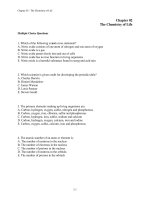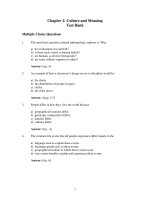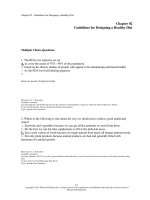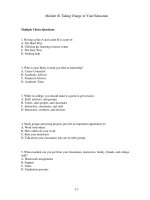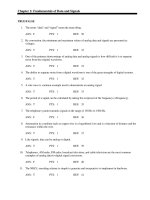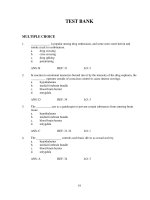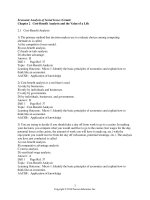Wardlaws perspectives in nutrition a functional approach 1st edition byrd bredbenner test bank
Bạn đang xem bản rút gọn của tài liệu. Xem và tải ngay bản đầy đủ của tài liệu tại đây (64.57 KB, 24 trang )
Chapter 02 - Tools of a Healthy Diet
Chapter 02
Tools of a Healthy Diet
Multiple Choice Questions
1. Which is true about the Dietary Reference Intakes (DRIs)?
A. They apply to people in Canada and the U.S.
B. They differ by age group.
C. They include Recommended Dietary Allowances and Tolerable Upper Intake Levels.
D. They were created by the Food and Nutrition Board.
E. All of these responses are true.
Bloom's: 1. Remember
Learning Outcome: 2.01 Explain the purpose of the Recommended Dietary Allowances (RDAs)
and relate them to the other standards included in the Dietary Reference Intakes.
Section: 2.01
Topic: Healthy Diet Guidelines
2. Dietary Reference Intakes (DRIs) values are for people who are ________.
A. 1 to 4 years of age
B. over 4 years of age
C. over 19 years of age
D. of all ages
Bloom's: 1. Remember
Learning Outcome: 2.01 Explain the purpose of the Recommended Dietary Allowances (RDAs)
and relate them to the other standards included in the Dietary Reference Intakes.
Section: 2.01
Topic: Healthy Diet Guidelines
2-1
© 2014 by McGraw-Hill Education. This is proprietary material solely for authorized instructor use. Not authorized for sale or distribution in
any manner. This document may not be copied, scanned, duplicated, forwarded, distributed, or posted on a website, in whole or part
Chapter 02 - Tools of a Healthy Diet
3. An Adequate Intake (AI) is set for a nutrient when ________.
A. too little research is available to establish an RDA
B. the needs during pregnancy decline instead of increase
C. the need for a nutrient depends on total calories eaten
D. the nutrient has a high potential for being toxic
Bloom's: 1. Remember
Learning Outcome: 2.01 Explain the purpose of the Recommended Dietary Allowances (RDAs)
and relate them to the other standards included in the Dietary Reference Intakes.
Section: 2.01
Topic: Healthy Diet Guidelines
4. Which Dietary Reference Intake (DRI) is set high enough to meet the needs of 97 to 98% of
the population?
A. Estimated Energy Requirements
B. Estimated Average Requirements
C. Recommended Dietary Allowances
D. Dietary Reference Intakes
Bloom's: 1. Remember
Learning Outcome: 2.01 Explain the purpose of the Recommended Dietary Allowances (RDAs)
and relate them to the other standards included in the Dietary Reference Intakes.
Section: 2.01
Topic: Healthy Diet Guidelines
2-2
© 2014 by McGraw-Hill Education. This is proprietary material solely for authorized instructor use. Not authorized for sale or distribution in
any manner. This document may not be copied, scanned, duplicated, forwarded, distributed, or posted on a website, in whole or part
Chapter 02 - Tools of a Healthy Diet
5. Tolerable Upper Intake Levels (ULs) are ________.
A. the maximum daily intake level not likely to cause harmful effects
B. based on intakes from only supplements and highly fortified foods
C. nutrient intake goals
D. set for all nutrients
Bloom's: 1. Remember
Learning Outcome: 2.01 Explain the purpose of the Recommended Dietary Allowances (RDAs)
and relate them to the other standards included in the Dietary Reference Intakes.
Section: 2.01
Topic: Healthy Diet Guidelines
6. Which Dietary Reference Intake (DRI) reflects average daily needs?
A. Adequate Intakes
B. Estimated Average Requirements
C. Recommended Dietary Allowances
D. Tolerable Upper Intake Levels
Bloom's: 2. Understand
Learning Outcome: 2.01 Explain the purpose of the Recommended Dietary Allowances (RDAs)
and relate them to the other standards included in the Dietary Reference Intakes.
Section: 2.01
Topic: Healthy Diet Guidelines
2-3
© 2014 by McGraw-Hill Education. This is proprietary material solely for authorized instructor use. Not authorized for sale or distribution in
any manner. This document may not be copied, scanned, duplicated, forwarded, distributed, or posted on a website, in whole or part
Chapter 02 - Tools of a Healthy Diet
7. The AMDRs do NOT include estimates for intake of ________.
A. essential fatty acids
B. essential amino acids
C. carbohydrate
D. fat
Bloom's: 1. Remember
Learning Outcome: 2.01 Explain the purpose of the Recommended Dietary Allowances (RDAs)
and relate them to the other standards included in the Dietary Reference Intakes.
Section: 2.01
Topic: Healthy Diet Guidelines
8. The Recommended Dietary Allowances (RDAs) for nutrients are ________.
A. the minimum amounts needed by an average 70-kg man
B. twice as high as almost everyone needs
C. average requirements for a population
D. designed to meet the nutrient needs of 97 to 98% of individuals in a specific life stage
Bloom's: 1. Remember
Learning Outcome: 2.01 Explain the purpose of the Recommended Dietary Allowances (RDAs)
and relate them to the other standards included in the Dietary Reference Intakes.
Section: 2.01
Topic: Healthy Diet Guidelines
2-4
© 2014 by McGraw-Hill Education. This is proprietary material solely for authorized instructor use. Not authorized for sale or distribution in
any manner. This document may not be copied, scanned, duplicated, forwarded, distributed, or posted on a website, in whole or part
Chapter 02 - Tools of a Healthy Diet
9. Foods that provide a greater contribution to nutrient needs than calorie needs are said to be
________.
A. empty calorie
B. energy dense
C. calorie dense
D. nutrient dense
Bloom's: 1. Remember
Learning Outcome: 2.01 Explain the purpose of the Recommended Dietary Allowances (RDAs)
and relate them to the other standards included in the Dietary Reference Intakes.
Section: 2.01
Topic: Nutrition Basics
10. The nutrient standards used on Nutrition Facts panels are called ________.
A. Recommended Dietary Allowances
B. Daily Values
C. Estimated Average Requirements
D. Dietary Reference Intakes
Bloom's: 1. Remember
Learning Outcome: 2.02 Compare the Daily Values to the Dietary Reference Intakes and
explain how they are used on Nutrition Facts panels.
Section: 2.02
Topic: Healthy Diet Guidelines
2-5
© 2014 by McGraw-Hill Education. This is proprietary material solely for authorized instructor use. Not authorized for sale or distribution in
any manner. This document may not be copied, scanned, duplicated, forwarded, distributed, or posted on a website, in whole or part
Chapter 02 - Tools of a Healthy Diet
11. Daily Values differ from Recommended Dietary Allowances in that Daily Values
________.
A. are used on Nutrition Facts panels
B. are not age-specific
C. are not gender-specific
D. All of these responses are correct
Bloom's: 2. Understand
Learning Outcome: 2.02 Compare the Daily Values to the Dietary Reference Intakes and
explain how they are used on Nutrition Facts panels.
Section: 2.02
Topic: Healthy Diet Guidelines
12. Daily Values are based on which sets of dietary standards?
A. Reference Daily Intakes and Daily Reference Values
B. Recommended Dietary Allowances and Daily Reference Values
C. Reference Daily Intakes and Tolerable Upper Intake Levels
D. Recommended Dietary Allowances and Reference Daily Intakes
Bloom's: 1. Remember
Learning Outcome: 2.02 Compare the Daily Values to the Dietary Reference Intakes and
explain how they are used on Nutrition Facts panels.
Section: 2.02
Topic: Healthy Diet Guidelines
2-6
© 2014 by McGraw-Hill Education. This is proprietary material solely for authorized instructor use. Not authorized for sale or distribution in
any manner. This document may not be copied, scanned, duplicated, forwarded, distributed, or posted on a website, in whole or part
Chapter 02 - Tools of a Healthy Diet
13. Daily Reference Values are set for ________.
A. fat and cholesterol
B. sodium and potassium
C. carbohydrate and protein
D. All of these responses are correct
Bloom's: 1. Remember
Learning Outcome: 2.02 Compare the Daily Values to the Dietary Reference Intakes and
explain how they are used on Nutrition Facts panels.
Section: 2.02
Topic: Healthy Diet Guidelines
14. The reference calorie intake for calculating percent Daily Values on Nutrition Facts labels
is ________.
A. 1500 kcal
B. 2000 kcal
C. 2300 kcal
D. 3000 kcal
Bloom's: 1. Remember
Learning Outcome: 2.02 Compare the Daily Values to the Dietary Reference Intakes and
explain how they are used on Nutrition Facts panels.
Section: 2.02
Topic: Healthy Diet Guidelines
2-7
© 2014 by McGraw-Hill Education. This is proprietary material solely for authorized instructor use. Not authorized for sale or distribution in
any manner. This document may not be copied, scanned, duplicated, forwarded, distributed, or posted on a website, in whole or part
Chapter 02 - Tools of a Healthy Diet
15. Which dietary standard values vary with calorie intake?
A. Fat
B. Vitamin C
C. Calcium
D. Iron
Bloom's: 2. Understand
Learning Outcome: 2.02 Compare the Daily Values to the Dietary Reference Intakes and
explain how they are used on Nutrition Facts panels.
Section: 2.02
Topic: Healthy Diet Guidelines
16. Which is required on a food package?
A. Name and address of the food manufacturer
B. Date and time of processing
C. Expiration date
D. Percent Daily Value for protein
Bloom's: 2. Understand
Learning Outcome: 2.02 Compare the Daily Values to the Dietary Reference Intakes and
explain how they are used on Nutrition Facts panels.
Section: 2.02
Topic: Nutrition Basics
2-8
© 2014 by McGraw-Hill Education. This is proprietary material solely for authorized instructor use. Not authorized for sale or distribution in
any manner. This document may not be copied, scanned, duplicated, forwarded, distributed, or posted on a website, in whole or part
Chapter 02 - Tools of a Healthy Diet
17. If a can of soup provides 4 servings and has 100 kcal per serving, how many kcal are in the
entire can?
A. 100
B. 200
C. 400
D. 800
100 kcal/serving x 4 servings/can = 400 kcal/can
Bloom's: 3. Apply
Learning Outcome: 2.03 Describe Nutrition Facts panels and the claims permitted on food
packages.
Section: 2.02
Topic: Nutrition Basics
18. Food components that must be listed on the Nutrition Facts panel include ________.
A. sugars, dietary fiber, and fluoride
B. sugars, dietary fiber, and calcium
C. sugars, dietary fiber, and monounsaturated fat
D. sugars, calcium, and B-vitamins
Bloom's: 2. Understand
Learning Outcome: 2.03 Describe Nutrition Facts panels and the claims permitted on food
packages.
Section: 2.02
Topic: Nutrition Basics
2-9
© 2014 by McGraw-Hill Education. This is proprietary material solely for authorized instructor use. Not authorized for sale or distribution in
any manner. This document may not be copied, scanned, duplicated, forwarded, distributed, or posted on a website, in whole or part
Chapter 02 - Tools of a Healthy Diet
19. Which claims are NOT closely regulated by the Food and Drug Administration (FDA)?
A. Health claims
B. Structure/function claims
C. Nutrient content claims
D. All of these
Bloom's: 2. Understand
Learning Outcome: 2.03 Describe Nutrition Facts panels and the claims permitted on food
packages.
Section: 2.02
Topic: Nutrition Basics
20. To be defined as a "good" source of calcium, a food must contain ________.
A. at least 5% of the Daily Value for calcium in 1 serving of the food
B. at least 10% of the Daily Value for calcium in 1 serving of the food
C. at least 50% of the Daily Value for calcium in 1 serving of the food
D. at least 50% of the Daily Value for calcium in 2 servings of the food
Bloom's: 1. Remember
Learning Outcome: 2.03 Describe Nutrition Facts panels and the claims permitted on food
packages.
Section: 2.02
Topic: Nutrition Basics
2-10
© 2014 by McGraw-Hill Education. This is proprietary material solely for authorized instructor use. Not authorized for sale or distribution in
any manner. This document may not be copied, scanned, duplicated, forwarded, distributed, or posted on a website, in whole or part
Chapter 02 - Tools of a Healthy Diet
21. When vitamins and/or minerals are added to a food product in amounts in excess of at least
10% above that originally present in the product, the food is designated as ________.
A. light or lite
B. organic
C. imitation
D. fortified
Bloom's: 1. Remember
Learning Outcome: 2.03 Describe Nutrition Facts panels and the claims permitted on food
packages.
Section: 2.02
Topic: Nutrition Basics
22. Which is NOT a permitted health claim?
A. Diets with enough calcium may reduce risk of osteoporosis.
B. Diets low in sugar may reduce the risk of cancer.
C. Diets low in saturated fat and cholesterol may reduce the risk of cardiovascular disease.
D. None of these responses are permitted.
Bloom's: 1. Remember
Learning Outcome: 2.03 Describe Nutrition Facts panels and the claims permitted on food
packages.
Section: 2.02
Topic: Nutrition Basics
2-11
© 2014 by McGraw-Hill Education. This is proprietary material solely for authorized instructor use. Not authorized for sale or distribution in
any manner. This document may not be copied, scanned, duplicated, forwarded, distributed, or posted on a website, in whole or part
Chapter 02 - Tools of a Healthy Diet
23. What type of claim is "calcium builds strong bones and teeth"?
A. Structure/function claim
B. Health claim
C. Nutrient claim
D. Preliminary health claim
Bloom's: 2. Understand
Learning Outcome: 2.03 Describe Nutrition Facts panels and the claims permitted on food
packages.
Section: 2.02
Topic: Nutrition Basics
24. For a health claim to be made about a food product, it must NOT contain more than
________.
A. 19 g fat
B. 70% carbohydrate
C. 4 g saturated fat
D. 120 mg cholesterol
E. All of these choices are correct
Bloom's: 1. Remember
Learning Outcome: 2.03 Describe Nutrition Facts panels and the claims permitted on food
packages.
Section: 2.02
Topic: Nutrition Basics
2-12
© 2014 by McGraw-Hill Education. This is proprietary material solely for authorized instructor use. Not authorized for sale or distribution in
any manner. This document may not be copied, scanned, duplicated, forwarded, distributed, or posted on a website, in whole or part
Chapter 02 - Tools of a Healthy Diet
25. Factors that affect the amount of nutrients in foods include ________.
A. farming conditions
B. ripeness of plants when harvested
C. cooking processes
D. length of time food is stored
E. All of these factors affect nutrient content of foods
Bloom's: 2. Understand
Learning Outcome: 2.04 Describe the uses and limitations of the data in nutrient databases.
Section: 2.03
Topic: Nutrition Basics
26. Energy-dense foods are ________.
A. high in calories
B. high in water
C. high in fiber
D. high in volume
Bloom's: 1. Remember
Learning Outcome: 2.04 Describe the uses and limitations of the data in nutrient databases.
Section: 2.03
Topic: Nutrition Basics
27. Nutrient databases can be used to determine ________.
A. a food's energy density
B. a food's nutrient density
C. the nutrient content of your diet
D. the nutrient content of the foods in a recipe
E. All of these responses are appropriate uses of nutrient databases
Bloom's: 2. Understand
Learning Outcome: 2.04 Describe the uses and limitations of the data in nutrient databases.
Section: 2.03
Topic: Nutrition Basics
2-13
© 2014 by McGraw-Hill Education. This is proprietary material solely for authorized instructor use. Not authorized for sale or distribution in
any manner. This document may not be copied, scanned, duplicated, forwarded, distributed, or posted on a website, in whole or part
Chapter 02 - Tools of a Healthy Diet
28. The Dietary Guidelines for Americans are designed to reduce the risk of ________.
A. cancer
B. cardiovascular disease
C. obesity
D. foodborne illness
E. All of these responses are correct
Bloom's: 1. Remember
Learning Outcome: 2.05 Discuss the 2010 Dietary Guidelines for Americans and the diseases
they are designed to prevent or minimize.
Section: 2.04
Topic: Healthy Diet Guidelines
29. The Dietary Guidelines for Americans ________.
A. provide a scientific basis for USDA's school lunch program
B. provide a scientific basis for the Food Stamp Program
C. are designed to reduce the risk of "killer" diseases
D. All of these choices are correct
Bloom's: 1. Remember
Learning Outcome: 2.05 Discuss the 2010 Dietary Guidelines for Americans and the diseases
they are designed to prevent or minimize.
Section: 2.04
Topic: Healthy Diet Guidelines
2-14
© 2014 by McGraw-Hill Education. This is proprietary material solely for authorized instructor use. Not authorized for sale or distribution in
any manner. This document may not be copied, scanned, duplicated, forwarded, distributed, or posted on a website, in whole or part
Chapter 02 - Tools of a Healthy Diet
30. According to the Dietary Guidelines for Americans, those who consume alcoholic
beverages should do so in moderation. Which of the following statements is true?
A. A moderate intake is 1 or fewer servings per day for women.
B. Beer is not considered an alcoholic beverage because it is mostly water.
C. An average serving of red wine is 1.6 ounces per glass.
D. To be considered an alcoholic beverage, distilled spirits must be at least 180 proof.
Bloom's: 1. Remember
Learning Outcome: 2.05 Discuss the 2010 Dietary Guidelines for Americans and the diseases
they are designed to prevent or minimize.
Section: 2.04
Topic: Healthy Diet Guidelines
31. Which government agency publishes the Dietary Guidelines for Americans?
A. USDA
B. USDHHS
C. FDA
D. UDSA and USDHHS
E. FDA and USDA
Bloom's: 1. Remember
Learning Outcome: 2.05 Discuss the 2010 Dietary Guidelines for Americans and the diseases
they are designed to prevent or minimize.
Section: 2.04
Topic: Healthy Diet Guidelines
2-15
© 2014 by McGraw-Hill Education. This is proprietary material solely for authorized instructor use. Not authorized for sale or distribution in
any manner. This document may not be copied, scanned, duplicated, forwarded, distributed, or posted on a website, in whole or part
Chapter 02 - Tools of a Healthy Diet
32. MyPlate groups foods into _____ major categories.
A. 2
B. 3
C. 4
D. 5
Bloom's: 1. Remember
Learning Outcome: 2.06 Discuss the MyPlate food groupings and plan a diet using this tool.
Section: 2.05
Topic: Healthy Diet Guidelines
33. Which is NOT a key behavior emphasized in MyPlate?
A. Balancing calories
B. Foods to increase
C. Disease prevention
D. Foods to reduce
Bloom's: 1. Remember
Learning Outcome: 2.06 Discuss the MyPlate food groupings and plan a diet using this tool.
Section: 2.05
Topic: Healthy Diet Guidelines
34. According to MyPlate, a mini bagel would represent _____ ounce(s) from the grains
group.
A. 0.50
B. 1
C. 2
D. 3
E. 4
Bloom's: 3. Apply
Learning Outcome: 2.06 Discuss the MyPlate food groupings and plan a diet using this tool.
Section: 2.05
Topic: Healthy Diet Guidelines
2-16
© 2014 by McGraw-Hill Education. This is proprietary material solely for authorized instructor use. Not authorized for sale or distribution in
any manner. This document may not be copied, scanned, duplicated, forwarded, distributed, or posted on a website, in whole or part
Chapter 02 - Tools of a Healthy Diet
35. Two cups of lettuce salad would equal a cup from which MyPlate food group?
A. Free
B. Others
C. Vegetable
D. Salad
Bloom's: 3. Apply
Learning Outcome: 2.06 Discuss the MyPlate food groupings and plan a diet using this tool.
Section: 2.05
Topic: Healthy Diet Guidelines
36. Which counts as one cup of fruit?
A. Large banana
B. Small apple
C. Medium pear
D. All of these
Bloom's: 1. Remember
Learning Outcome: 2.07 Develop a healthy eating plan based on the concepts of variety,
balance, modeeration, nutrient density, and energy density.
Section: 2.05
Topic: Healthy Diet Guidelines
2-17
© 2014 by McGraw-Hill Education. This is proprietary material solely for authorized instructor use. Not authorized for sale or distribution in
any manner. This document may not be copied, scanned, duplicated, forwarded, distributed, or posted on a website, in whole or part
Chapter 02 - Tools of a Healthy Diet
37. MyPlate includes which food group?
A. Dairy
B. Vegetables
C. Protein foods
D. Fruits
E.
All of these
Bloom's: 1. Remember
Learning Outcome: 2.06 Discuss the MyPlate food groupings and plan a diet using this tool.
Section: 2.05
Topic: Healthy Diet Guidelines
38. What eating behavior does MyPlate encourage?
A. Make half your plate vegetables.
B. Make half your plate grains.
C. Make at least half your grains whole grains.
D. Switch to fat-free or low-fat milk.
E. Both C and D.
Bloom's: 1. Remember
Learning Outcome: 2.06 Discuss the MyPlate food groupings and plan a diet using this tool.
Section: 2.05
Topic: Healthy Diet Guidelines
2-18
© 2014 by McGraw-Hill Education. This is proprietary material solely for authorized instructor use. Not authorized for sale or distribution in
any manner. This document may not be copied, scanned, duplicated, forwarded, distributed, or posted on a website, in whole or part
Chapter 02 - Tools of a Healthy Diet
39. What counts as a cup in the dairy group?
A. 1 cup of ice cream
B. 1 cup of yogurt
C. 1 cup of cottage cheese
D. 1 cup grated cheese
Bloom's: 1. Remember
Learning Outcome: 2.06 Discuss the MyPlate food groupings and plan a diet using this tool.
Section: 2.05
Topic: Healthy Diet Guidelines
40. According to MyPlate, four ounces of processed cheese equals ____ servings from the milk
group.
A. 1
B. 2
C. 3
D. 4
Bloom's: 3. Apply
Learning Outcome: 2.06 Discuss the MyPlate food groupings and plan a diet using this tool.
Section: 2.05
Topic: Healthy Diet Guidelines
41. Which nutrients are contributed by the fruit group of MyPlate?
A. calcium
B. folate
C. zinc
D. protein
Bloom's: 2. Understand
Learning Outcome: 2.06 Discuss the MyPlate food groupings and plan a diet using this tool.
Section: 2.05
Topic: Healthy Diet Guidelines
2-19
© 2014 by McGraw-Hill Education. This is proprietary material solely for authorized instructor use. Not authorized for sale or distribution in
any manner. This document may not be copied, scanned, duplicated, forwarded, distributed, or posted on a website, in whole or part
Chapter 02 - Tools of a Healthy Diet
42. Which nutrients are contributed by the protein foods group of MyPlate?
A. iron
B. calcium
C. vitamin C
D. folate
Bloom's: 2. Understand
Learning Outcome: 2.06 Discuss the MyPlate food groupings and plan a diet using this tool.
Section: 2.05
Topic: Healthy Diet Guidelines
43. The MyPlate vegetable group is divided into which subgroups?
A. Starchy vegetables, red & orange vegetables, and dark green vegetables
B. Dark green vegetables and other vegetables
C. Other vegetables, starchy vegetables, and red & yellow vegetables
D. Dark green vegetables, red & orange vegetables, starchy vegetables, beans and peas, and
other vegetables
Bloom's: 1. Remember
Learning Outcome: 2.06 Discuss the MyPlate food groupings and plan a diet using this tool.
Section: 2.05
Topic: Healthy Diet Guidelines
44. A balanced diet is one that ________.
A. includes foods from every food group in the recommended amounts
B. includes different foods from each food group
C. keeps portion sizes under control
D. incorporates dietary supplements
Bloom's: 1. Remember
Learning Outcome: 2.07 Develop a healthy eating plan based on the concepts of variety,
balance, modeeration, nutrient density, and energy density.
Section: 2.05
Topic: Healthy Diet Guidelines
2-20
© 2014 by McGraw-Hill Education. This is proprietary material solely for authorized instructor use. Not authorized for sale or distribution in
any manner. This document may not be copied, scanned, duplicated, forwarded, distributed, or posted on a website, in whole or part
Chapter 02 - Tools of a Healthy Diet
45. Moderation in one's diet means that the diet ________.
A. includes foods from every food group in the recommended amounts
B. includes different foods from each food group
C. keeps portion sizes under control
D. incorporates dietary supplements
Bloom's: 1. Remember
Learning Outcome: 2.07 Develop a healthy eating plan based on the concepts of variety,
balance, modeeration, nutrient density, and energy density.
Section: 2.05
Topic: Healthy Diet Guidelines
46. Reading food labels helps consumers ________.
A. identify amounts of salt or sodium in the product
B. determine the sugar content of the product
C. determine amount and kind of fat in the product
D. choose foods with dietary fiber
E. All of these responses are correct
Bloom's: 2. Understand
Learning Outcome: 2.02 Compare the Daily Values to the Dietary Reference Intakes and
explain how they are used on Nutrition Facts panels.
Section: 2.02
Topic: Nutrition Basics
2-21
© 2014 by McGraw-Hill Education. This is proprietary material solely for authorized instructor use. Not authorized for sale or distribution in
any manner. This document may not be copied, scanned, duplicated, forwarded, distributed, or posted on a website, in whole or part
Chapter 02 - Tools of a Healthy Diet
47. Mandatory labeling of foods is regulated by the ________.
A. USDHHS
B. FTC
C. FDA
D. GAO
Bloom's: 1. Remember
Learning Outcome: 2.02 Compare the Daily Values to the Dietary Reference Intakes and
explain how they are used on Nutrition Facts panels.
Section: 2.02
Topic: Nutrition Basics
48. Labeling laws require that ingredients in food products be listed on the container in
descending order of their ________.
A. calories
B. nutrient density
C. weight
D. cost
Bloom's: 1. Remember
Learning Outcome: 2.02 Compare the Daily Values to the Dietary Reference Intakes and
explain how they are used on Nutrition Facts panels.
Section: 2.02
Topic: Nutrition Basics
2-22
© 2014 by McGraw-Hill Education. This is proprietary material solely for authorized instructor use. Not authorized for sale or distribution in
any manner. This document may not be copied, scanned, duplicated, forwarded, distributed, or posted on a website, in whole or part
Chapter 02 - Tools of a Healthy Diet
49. Under the current law on nutrition labeling, the Nutrition Facts panel must include
________.
A. total calories from fat
B. total calories from trans fat
C. total calories from saturated fat
D. grams of monounsaturated fat
Bloom's: 2. Understand
Learning Outcome: 2.02 Compare the Daily Values to the Dietary Reference Intakes and
explain how they are used on Nutrition Facts panels.
Section: 2.02
Topic: Nutrition Basics
True / False Questions
50. The FDA has expressed concern about nutrition symbols (e.g., check marks) placed on the
front of food packages because inconsistent criteria were used to determine if a food was
eligible for a symbol.
TRUE
Bloom's: 1. Remember
Learning Outcome: 2.02 Compare the Daily Values to the Dietary Reference Intakes and
explain how they are used on Nutrition Facts panels.
Section: 2.02
Topic: Nutrition Basics
2-23
© 2014 by McGraw-Hill Education. This is proprietary material solely for authorized instructor use. Not authorized for sale or distribution in
any manner. This document may not be copied, scanned, duplicated, forwarded, distributed, or posted on a website, in whole or part
Chapter 02 - Tools of a Healthy Diet
51. About half of the money Americans spend on food is used to buy foods prepared outside
the home.
TRUE
Bloom's: 1. Remember
Learning Outcome: 2.04 Describe the uses and limitations of the data in nutrient databases.
Section: 2.03
Topic: Healthy Diet Guidelines
52. Those who frequently eat at fast foods restaurants have an increased risk for obesity.
TRUE
Bloom's: 1. Remember
Learning Outcome: 2.03 Describe Nutrition Facts panels and the claims permitted on food
packages.
Section: 2.03
Topic: Healthy Diet Guidelines
2-24
© 2014 by McGraw-Hill Education. This is proprietary material solely for authorized instructor use. Not authorized for sale or distribution in
any manner. This document may not be copied, scanned, duplicated, forwarded, distributed, or posted on a website, in whole or part
